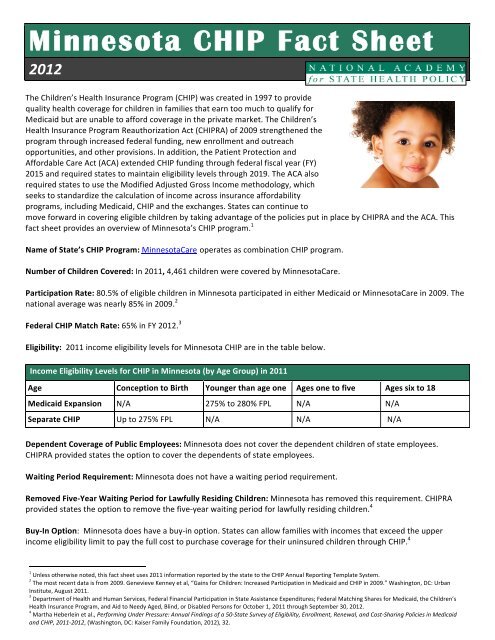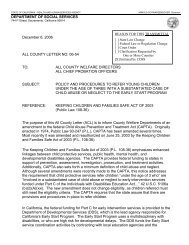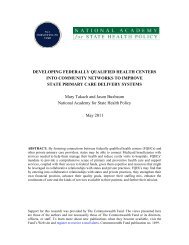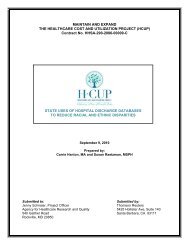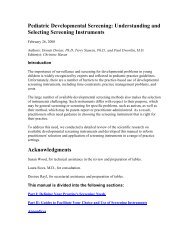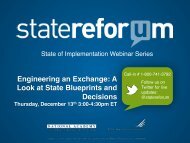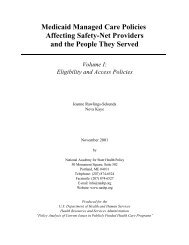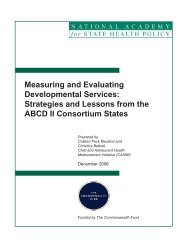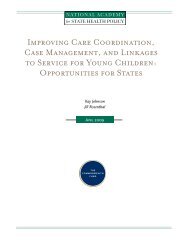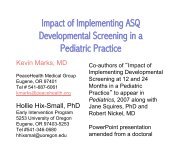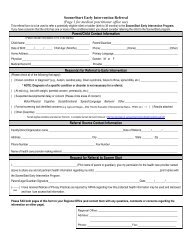Minnesota CHIP Fact Sheet - National Academy for State Health Policy
Minnesota CHIP Fact Sheet - National Academy for State Health Policy
Minnesota CHIP Fact Sheet - National Academy for State Health Policy
You also want an ePaper? Increase the reach of your titles
YUMPU automatically turns print PDFs into web optimized ePapers that Google loves.
<strong>Minnesota</strong> <strong>CHIP</strong> <strong>Fact</strong> <strong>Sheet</strong><br />
2012<br />
The Children’s <strong>Health</strong> Insurance Program (<strong>CHIP</strong>) was created in 1997 to provide<br />
quality health coverage <strong>for</strong> children in families that earn too much to qualify <strong>for</strong><br />
Medicaid but are unable to af<strong>for</strong>d coverage in the private market. The Children’s<br />
<strong>Health</strong> Insurance Program Reauthorization Act (<strong>CHIP</strong>RA) of 2009 strengthened the<br />
program through increased federal funding, new enrollment and outreach<br />
opportunities, and other provisions. In addition, the Patient Protection and<br />
Af<strong>for</strong>dable Care Act (ACA) extended <strong>CHIP</strong> funding through federal fiscal year (FY)<br />
2015 and required states to maintain eligibility levels through 2019. The ACA also<br />
required states to use the Modified Adjusted Gross Income methodology, which<br />
seeks to standardize the calculation of income across insurance af<strong>for</strong>dability<br />
programs, including Medicaid, <strong>CHIP</strong> and the exchanges. <strong>State</strong>s can continue to<br />
move <strong>for</strong>ward in covering eligible children by taking advantage of the policies put in place by <strong>CHIP</strong>RA and the ACA. This<br />
fact sheet provides an overview of <strong>Minnesota</strong>’s <strong>CHIP</strong> program. 1<br />
Name of <strong>State</strong>’s <strong>CHIP</strong> Program: <strong>Minnesota</strong>Care operates as combination <strong>CHIP</strong> program.<br />
Number of Children Covered: In 2011, 4,461 children were covered by <strong>Minnesota</strong>Care.<br />
Participation Rate: 80.5% of eligible children in <strong>Minnesota</strong> participated in either Medicaid or <strong>Minnesota</strong>Care in 2009. The<br />
national average was nearly 85% in 2009. 2<br />
Federal <strong>CHIP</strong> Match Rate: 65% in FY 2012. 3<br />
Eligibility: 2011 income eligibility levels <strong>for</strong> <strong>Minnesota</strong> <strong>CHIP</strong> are in the table below.<br />
Income Eligibility Levels <strong>for</strong> <strong>CHIP</strong> in <strong>Minnesota</strong> (by Age Group) in 2011<br />
Age Conception to Birth Younger than age one Ages one to five Ages six to 18<br />
Medicaid Expansion N/A 275% to 280% FPL N/A N/A<br />
Separate <strong>CHIP</strong> Up to 275% FPL N/A N/A N/A<br />
Dependent Coverage of Public Employees: <strong>Minnesota</strong> does not cover the dependent children of state employees.<br />
<strong>CHIP</strong>RA provided states the option to cover the dependents of state employees.<br />
Waiting Period Requirement: <strong>Minnesota</strong> does not have a waiting period requirement.<br />
Removed Five-‐Year Waiting Period <strong>for</strong> Lawfully Residing Children: <strong>Minnesota</strong> has removed this requirement. <strong>CHIP</strong>RA<br />
provided states the option to remove the five-‐year waiting period <strong>for</strong> lawfully residing children. 4<br />
Buy-‐In Option: <strong>Minnesota</strong> does have a buy-‐in option. <strong>State</strong>s can allow families with incomes that exceed the upper<br />
income eligibility limit to pay the full cost to purchase coverage <strong>for</strong> their uninsured children through <strong>CHIP</strong>. 4<br />
1<br />
Unless otherwise noted, this fact sheet uses 2011 in<strong>for</strong>mation reported by the state to the <strong>CHIP</strong> Annual Reporting Template System.<br />
2<br />
The most recent data is from 2009. Genevieve Kenney et al, “Gains <strong>for</strong> Children: Increased Participation in Medicaid and <strong>CHIP</strong> in 2009.” Washington, DC: Urban<br />
Institute, August 2011.<br />
3<br />
Department of <strong>Health</strong> and Human Services, Federal Financial Participation in <strong>State</strong> Assistance Expenditures; Federal Matching Shares <strong>for</strong> Medicaid, the Children’s<br />
<strong>Health</strong> Insurance Program, and Aid to Needy Aged, Blind, or Disabled Persons <strong>for</strong> October 1, 2011 through September 30, 2012.<br />
4<br />
Martha Heberlein et al., Per<strong>for</strong>ming Under Pressure: Annual Findings of a 50-‐<strong>State</strong> Survey of Eligibility, Enrollment, Renewal, and Cost-‐Sharing Policies in Medicaid<br />
and <strong>CHIP</strong>, 2011-‐2012, (Washington, DC: Kaiser Family Foundation, 2012), 32.
<strong>State</strong> <strong>CHIP</strong> <strong>Fact</strong> <strong>Sheet</strong>—<strong>Minnesota</strong><br />
Ef<strong>for</strong>ts to Simplify Enrollment and Renewals: To reduce barriers to enrollment and renewal in <strong>CHIP</strong>, states have the<br />
option to implement a range of strategies to streamline these processes. The table below describes some of these<br />
strategies, specifically those that are considered <strong>for</strong> <strong>CHIP</strong>RA per<strong>for</strong>mance bonuses. <strong>State</strong>s that have implemented some of<br />
the strategies in their Medicaid and/or <strong>CHIP</strong> programs may qualify <strong>for</strong> a <strong>CHIP</strong>RA per<strong>for</strong>mance bonus.<br />
Ef<strong>for</strong>ts <strong>for</strong> Simplifying Enrollment and Renewal in <strong>CHIP</strong> in <strong>Minnesota</strong> (as of Dec. 31, 2011)<br />
Strategy Explanation Used in <strong>CHIP</strong><br />
Presumptive eligibility The state allows certain entities to make a preliminary determination and temporarily enroll<br />
children in the program who appear to be eligible, pending a full determination of eligibility.<br />
No asset test The state has eliminated the asset or resource test requirement. Yes<br />
No in-‐person interview The state does not require an in-‐person interview as part of the application or renewal<br />
process.<br />
Use joint application and<br />
renewal <strong>for</strong>ms <strong>for</strong><br />
Medicaid and <strong>CHIP</strong><br />
Automatic/Administrative<br />
renewal<br />
Continuous eligibility <strong>for</strong> 12<br />
months<br />
CHIIPRA Per<strong>for</strong>mance Bonus: <strong>CHIP</strong>RA established a per<strong>for</strong>mance bonus fund to provide additional federal funding to<br />
states that have implemented at least five of the eight enrollment and renewal procedures described above in their<br />
Medicaid and/or <strong>CHIP</strong> programs, and that have achieved a targeted increase in enrollment of children in Medicaid. In<br />
2011, <strong>Minnesota</strong> did not qualify <strong>for</strong> a per<strong>for</strong>mance bonus.<br />
Cost Sharing Requirements:<br />
Premiums Deductible Copayments/Coinsurance<br />
No No No<br />
Benefits and Delivery System:<br />
• Same delivery system or provider networks used in Medicaid and <strong>CHIP</strong>: Yes, the state uses a managed care delivery<br />
system.<br />
• Changes in benefits in 2011: No<br />
The state uses the same or interchangeable application and renewal <strong>for</strong>ms <strong>for</strong> establishing<br />
and renewing eligibility.<br />
The state uses administrative redetermination (the provision of a pre-‐populated <strong>for</strong>m with<br />
eligibility in<strong>for</strong>mation along with a notice indicating that eligibility will be continued) or ex<br />
parte redetermination (the state renews eligibility based on in<strong>for</strong>mation contained in the<br />
applicant’s file or based on other in<strong>for</strong>mation made available to the state) to renew<br />
coverage.<br />
The state allows children to retain coverage <strong>for</strong> 12 months, regardless of whether their<br />
family income changes during that time period.<br />
Express Lane Eligibility The state uses eligibility determinations from other public programs to determine if a child is<br />
eligible.<br />
Premium Assistance The state uses <strong>CHIP</strong> funds to subsidize the cost of private health insurance coverage <strong>for</strong><br />
children eligible <strong>for</strong> the program.<br />
For more in<strong>for</strong>mation, please contact the <strong>National</strong> <strong>Academy</strong> <strong>for</strong> <strong>State</strong> <strong>Health</strong> <strong>Policy</strong> at info@nashp.org.<br />
No<br />
Yes<br />
Yes<br />
No<br />
No<br />
No<br />
No


